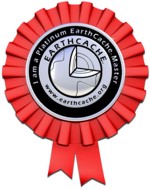From the guidelines: "People do not need to wait for permission to log your EarthCache. Requiring someone to wait is not supported by the EarthCache guidelines. People should send their logging task answers to you, then log your EarthCache. When you review their logging task answers, if there is a problem, you should contact them to resolve it. If there is no problem, then their log simply stands."

Introduction – we walk amongst geological treasures and yet the majority of us do not register their presence. This EC is one such case: the forgotten ammonite fossil.
What can you learn from this EC? – You can see a large ammonite and its internal structure.
Fossils (from Latin fossus, literally "having been dug up") are the preserved remains or traces of animals.
 Ammonites are an extinct group of marine invertebrate animals in the subclass Ammonoidea of the class Cephalopoda. These molluscs are more closely related to living coleoids (i.e. octopuses, squid, and cuttlefish) than they are to shelled nautiloids such as the living Nautilus species.
Ammonites are an extinct group of marine invertebrate animals in the subclass Ammonoidea of the class Cephalopoda. These molluscs are more closely related to living coleoids (i.e. octopuses, squid, and cuttlefish) than they are to shelled nautiloids such as the living Nautilus species.
Ammonites are excellent index fossils, and it is often possible to link the rock layer in which they are found to specific geological time periods. Their fossil shells usually take the form of planispirals, although there were some helically-spiraled and non-spiraled forms (known as heteromorphs).
 The name ammonite, from which the scientific term is derived, was inspired by the spiral shape of their fossilized shells, which somewhat resemble tightly coiled rams' horns.
The name ammonite, from which the scientific term is derived, was inspired by the spiral shape of their fossilized shells, which somewhat resemble tightly coiled rams' horns.
This ammonite is preserved in limestone of Jurassic age that was quarried from the Lusitanian Basin (stretching along the mid Portuguese coast with part on land and part off shore) located approximately 100 km north of Lisbon.
In order to claim this EarthCache you will need a measuring device (ruler, tape measure) and be able to answer the following questions:
1- What is the diameter of the ammonite fossil?
2- What is the width of the inner chambers of this ammonite? And,
3- Do you see the ammonite inner coils or not? i.e. do you see a perfect spiral or do you only see a partial spiral?
If you think you have the right answers, log the cache but ALSO send me the answers via my profile with the following information:
- Identification of the cache
- Answers
- (please click: I want to send my e-mail along with this)

If I don’t answer you it is because you have passed the test.
Do not place pictures of the ammonite in the logs. Spoiler logs will be deleted.
http://en.wikipedia.org/wiki/Ammonoidea
http://pt.wikipedia.org/wiki/F%C3%B3ssil

Introdução - Nós caminhamos entre tesouros geológicos e mesmo assim a maioria de nós não regista a sua presença. Esta CE retrata um destes casos: o fóssil da amonite esquecida.
O que podes aprender com esta EC – ver um fóssil de uma amonite e a sua estrutura interna.
Fóssil – Os fósseis são restos de seres vivos ou vestígios de actividades biológicas (ovos, pegadas, etc.) preservados em diversos materiais.
Os amonóides (do latim científico Ammonoidea), também referidos como amonites, constituem um grupo extinto de moluscos cefalópodes surgido no período Devónico e que desapareceu na extinção K-T, no final do Cretácico, que também vitimou os dinossauros.
As amonites eram animais marinhos, que ocupavam o nicho ecológico das actuais lulas. Tinham dimensões muito variáveis, desde alguns centímetros a um metro de diâmetro. O animal vivia dentro de uma concha em espiral de natureza carbonatada, semelhante à dos Nautilus actuais.
As conchas de amonite são um tipo comum de fóssil em formações marinhas do Mesozóico. Em estratigrafia, as amonites são consideradas excelentes fósseis de idade.
As amonites viviam no meio aquático e eram carnívoras, usavam os seus tentáculos como pés para se deslocarem.
 Esta amonite está preservada em calcários provenientes do Maciço Calcário Estremenho. É um grande bloco de calcários jurássicos com cerca de 160 milhões de anos, situado entre Rio Maior, Tomar e Leiria. Com aproximadamente 800 km2, o Maciço Calcário Estremenho constitui um relevo vigoroso que cria paisagens peculiares como os lapiaz, as dolinas, as uvalas, o polje e os algares.
Esta amonite está preservada em calcários provenientes do Maciço Calcário Estremenho. É um grande bloco de calcários jurássicos com cerca de 160 milhões de anos, situado entre Rio Maior, Tomar e Leiria. Com aproximadamente 800 km2, o Maciço Calcário Estremenho constitui um relevo vigoroso que cria paisagens peculiares como os lapiaz, as dolinas, as uvalas, o polje e os algares.
Do ponto de vista morfológico podem diferenciar-se neste maciço três áreas distintas: a serra dos Candeeiros, a oeste, o planalto de Santo António, ao centro e sul, e o planalto de S. Mamede e a serra de Aire, a norte e a este, respectivamente.
Para poderes registar o log de “FOUND IT” nesta EC terás de levar contigo material de medição (régua, fita métrica) e responder às seguintes perguntas:
- Qual o diâmetro desta amonite?
- Qual é a largura (em cm) das câmaras internas desta amonite? E, finalmente,
- Consegues ver as espirais internas desta amonite? Ou seja, consegues ver as espirais do centro da amonite?
Se pensas que passaste no teste faz o log de found mas envia-me também as respostas com a 1- a identificação da cache; 2- respostas e selecciona “I want to send my e-mail along with this message.” Se não te responder é porque passaste no teste e estás de parabéns. Caso contrário irás receber uma resposta.
Não coloquem fotos da amonite nos logs. Logs com spoilers serão eliminados.

 The most exciting way to learn about the Earth and its processes is to get into the outdoors and experience it first-hand. Visiting an Earthcache is a great outdoor activity the whole family can enjoy. An Earthcache is a special place that people can visit to learn about a unique geoscience feature or aspect of our Earth. Earthcaches include a set of educational notes and the details about where to find the location (latitude and longitude). Visitors to Earthcaches can see how our planet has been shaped by geological processes, how we manage the resources and how scientists gather evidence to learn about the Earth. To find out more click HERE.
The most exciting way to learn about the Earth and its processes is to get into the outdoors and experience it first-hand. Visiting an Earthcache is a great outdoor activity the whole family can enjoy. An Earthcache is a special place that people can visit to learn about a unique geoscience feature or aspect of our Earth. Earthcaches include a set of educational notes and the details about where to find the location (latitude and longitude). Visitors to Earthcaches can see how our planet has been shaped by geological processes, how we manage the resources and how scientists gather evidence to learn about the Earth. To find out more click HERE.